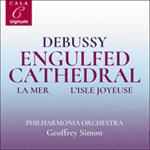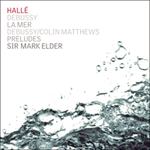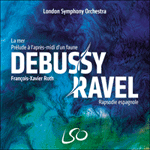
Welcome to Hyperion Records, a British classical label devoted to presenting high-quality recordings of music of all styles and from all periods from the twelfth century to the twenty-first.
Hyperion offers both CDs, and downloads in a number of formats. The site is also available in several languages.
Please use the dropdown buttons to set your preferred options, or use the checkbox to accept the defaults.

The sources for its ideas are many and varied. Pictorial associations are obviously strong, though less with ‘Impressionistic’ techniques as such than with the dreamlike images of Turner (who roused Debussy’s enthusiasm in advance of the painter’s wider popularity). One should also remember the example of Cézanne in demonstrating that even shadows are composed of colours; and the spirit of Hokusai, a reproduction of whose Wave decorated the cover of La mer on its first publication. ‘Music has this over painting’, Debussy wrote, ‘it can bring together all manner of variations in colour and light as they continually change in time’.
To these factors may be added the composer’s Proustian inclinations in the reconstruction of time through forgotten dreams and aspirations. During the composition of La mer he wrote to the conductor and composer André Messager: I was destined for the fine life of a sailor … I still have a great passion for the sea. You will say that the ocean does not exactly wash the hills of Burgundy, and that what I am doing might be like painting landscapes in a studio. But I have an endless store of memories, which I consider are worth more than reality.’
The composition was begun at Bichain in Burgundy in the summer of 1903, but it was not finished until early in 1905, and first performed in Paris on 15 October that year. Dates noted by the composer contradict the suggestion that he completed it on a visit to Eastbourne, also in 1905 (and where, he observed, ‘the sea displays itself with a correctness truly British’). And it is the sea alone, unaffected by human elements, that he portrays in his Symphonic Sketches – these are sketches in the sense of pictorial images and symphonic only in matters of harmonic relationship and cyclic form, whereby two themes from the first movement are brought back in the finale. Debussy is mostly concerned to extend kaleidoscopic mixtures of thematic fragments as through a prism, reflecting the visual sensations of light and shade in constantly shifting perspective. To achieve this, he treated his orchestra in a way that is familiar enough today, but which was highly original in his own time. Each instrument, including the severally divided strings in various passages, becomes a separate contributor to the changing textures, and these in turn shape a formal pattern as restless as the sea’s natural surface.
The first movement, ‘From Dawn to Noon on the Sea’, acts as a kind of prelude, evoking a seascape gradually emerging out of the misty dawn to gather substance and character in the strengthening morning light. Soon after the introduction, a thread of melody is spun by cor anglais and muted trumpet before the speed increases as the waves become more turbulent, rising to a majestic climax before the swell subsides. A kind of chorale sounds in the depths as the sun reaches its zenith, and one last wave breaks into foam. ‘The Play of the Waves’ is a scherzo, the sea awakened to spray-splashing movement as a species of dance which has no need of formal analysis for its enjoyment. Neither has the finale, the ‘Dialogue of the Wind and the Sea’, in gusty, turbulent motion. The sea becomes an all-embracing force, sometimes terrifying, always dominating, and the endless pulsating swell should continue in the mind and imagination long after the music has ceased.
from notes by Noël Goodwin © 2010
Les sources d’inspiration en sont nombreuses et variées. A l’évidence, les associations avec l’art pictural sont fortes, même si c’est moins avec les techniques impressionnistes qu’avec les visions oniriques de Turner (qui suscitèrent l’enthousiasme de Debussy bien avant que le peintre n’acquît une notoriété plus large. On peut également déceler l’exemple de Cézanne, lorsqu’il montrait que même les ombres étaient composées de couleurs ; et l’esprit d’Hokusai, dont une reproduction de la Vague orne la couverture de la première édition de La mer: «La musique a de cela supérieur à la peinture», écrivit Debussy, «qu’elle peut centraliser les variations de couleur et de lumière d’un même aspect.»
A ces éléments, on peut ajouter la propention proustienne du compositeur à reconstruire le temps au travers de rêves et d’aspirations oubliées. Durant la composition de La mer, il écrivit au chef d’orchestre et compositeur André Messager: «J’étais destiné à la merveilleuse vie de marin. Seul le hazard m’en détourna; je n’en conservais pas moins une passion sincère pour la mer. Vous me direz que l’océan ne baigne pas précisément les coteaux bourguignons …! et cela pourrait bien ressembler aux paysages d’atelier, mais j’ai d’innombrables souvenirs; cela vaut mieux à mon sens qu’une réalité dont le charme pèse généralement trop lourd sur votre pensée.»
La composition débuta à Bichain, en Bourgogne, durant l’été 1903, mais ne fut pas achevée avant le début de 1905; la création eut lieu à Paris le 15 octobre de la même année. Les dates indiquées par le compositeur contredisent l’idée qu’il acheva la partition à l’occasion d’un séjour à Eastbourne, qui eut lieu en 1905 (et où, observa-t-il, «où la mer s’exhibe avec une correction purement britannique»). Et c’est la mer seule, vierge de tout paramètre humain, qui est peinte dans ses «esquisses symphoniques» – «esquisses» dans le sens d’images picturales, et «symphoniques» seulement par le jeu de relations harmoniques et par la forme cyclique, deux thèmes du premier mouvement réapparaissant dans le finale. La préoccupation principale de Debussy est le déploiement, comme à travers un prisme, de fragments thématiques juxtaposés à la manière d’un kaléidoscope, afin de refléter les sensations visuelles de la lumière et de l’ombre dans une perspective en perpétuelle mutation. Pour parvenir à ses fins, il traite son orchestre d’une manière qui nous est aujourd’hui assez familière, mais qui témoignait à l’époque d’une grande originalité. Chaque instrument, y compris les cordes par endroits très divisées, apporte sa contribution individuelle à ces textures changeantes, lesquelles constituent un schéma formel aussi agité que la surface de la mer.
Le premier mouvement, «De l’aube à midi sur la mer», fait d’une certaine manière office de prélude, évoquant un panorama marin émergeant progressivement de l’aurore brumeuse et prenant corps et caractère dans l’intensification de la lumière matinale. Peu après l’introduction, un fil mélodique est tendu par le cor anglais et la trompette avec sourdine avant que le tempo n’accélère au fur et à mesure que les flots se font plus turbulents, jusqu’à une culmination majestueuse précédant l’apaisement de la houle. Une sorte de choral sourd des profondeurs, tandis que le soleil atteint son zénith, et une dernière vague se brise en écume. «Jeux de vagues» est un scherzo où la mer s’agite en une projection d’embruns, sorte de danse qui n’a nullement besoin d’une analyse formelle pour être appréciée. Il en va de même pour le finale, «Dialogue du vent et de la mer», au mouvement gusty, turbulent. La mer devient une puissance universelle, parfois effrayante, toujours dominatrice, et la pulsation inextinguible de la houle continue de hanter l’esprit et l’imagination bien après que la musique s’est tue.
extrait des notes rédigées par Noël Goodwin © 2010
Français: Claire Delamarche
Es gibt zahlreiche und unterschiedliche Quellen für die Ideen des Werkes. Bildhafte Anregungen sind offensichtlich stark, wenn auch sie sich weniger an „impressionistischen“ Techniken an sich als an den traumhaften Abbildungen Turners orientieren (Debussys begeisterte sich schon für Turner, bevor sich der Maler allgemeiner Beliebtheit erfreute). Man sollte sich auch an das Beispiel von Cézanne erinnern, der zeigte, dass selbst Schatten aus Farben zusammengesetzt sind, sowie an den Geist von Hokusai, dessen Welle auf dem Titelblatt der ersten Partiturausgabe von La mer abgebildet war. „Der Vorteil von Musik über Malerei“, schrieb Debussy, „besteht darin, dass sie alle Arten von Farb- und Lichtschattierungen bei ihren ständigen zeitlichen Veränderungen zusammenführen kann.“
Zu diesen Quellen können auch die Neigungen des Komponisten zu einer an Proust erinnernden Rekonstruktion der Zeit durch vergessene Träume und Aspirationen hinzugefügt werden. Während der Komposition von La mer schrieb Debussy an den Dirigenten und Komponisten André Messager: „Vielleicht wissen Sie nicht, dass ich für das schöne Leben eines Seemannes bestimmt war … Aber immer noch fühle ich eine starke Leidenschaft für das Meer. Sie werden sicherlich sagen, dass das Meer nicht die burgundischen Hügel umspült und dass ich das gleiche tue wie ein Maler, der eine Landschaft im Atelier malt. Aber ich bewahre unendlich viele Erinnerungen, und das erscheint mir wichtiger als die Wirklichkeit.”
Die Komposition wurde in Bichain, Burgund im Sommer 1903 begonnen, aber erst Anfang 1905 beendet und am 15. Oktober jenen Jahres in Paris uraufgeführt. Die Datumsangaben des Komponisten widersprechen der Behauptung, Debussy habe das Werk bei einem Besuch in Eastbourne, also 1905, abgeschlossen (wo sich, nach seiner Aussage, „das Meer mit einer typisch britischen Korrektheit präsentiert“). In seinen Sinfonischen Skizzen porträtiert er das Meer allein, unbeeinflusst von menschlichen Elementen. Mit „Skizzen“ sind hier bildhafte Eindrücke gemeint, mit „sinfonisch“ nur die harmonischen Verwandtschaften und zyklische Form, wobei zwei Themen aus dem ersten Satz im abschließenden Satz wieder aufgenommen werden. Debussy bemüht sich vornehmlich um einen Zuwachs an kaleidoskopischen Mischungen aus thematischen Fragmenten, als würden sie prismatisch gebrochen. Das entspricht den visuellen Wahrnehmungen von Licht und Schatten aus sich ständig wandelnden Perspektiven. Um das zu erreichen, behandelt der Komponist sein Orchester auf eine Art, die heutzutage weithin vertraut ist, zu Debussys Zeiten aber äußerst originell war. Jedes Instrument, einschließlich der mehrfach geteilten Streicher in verschiedenen Passagen, liefert einen separaten Beitrag zu den veränderlichen Texturen, und diese wiederum bilden eine formale Gestalt, die so ruhelos wie die natürliche Oberfläche des Meeres ist.
Der erste Satz „Morgengrauen bis Mittag auf dem Meer“ übernimmt die Funktion eines Vorspiels und beschwört eine Meereslandschaft, die sich allmählich aus dem nebligen Morgengrauen herausschält und bei zunehmendem Morgenlicht an Substanz und Charakter gewinnt. Kurz nach der Einleitung wird vom Englischhorn und der gedämpften Trompete ein Melodiefaden gesponnen, worauf das Tempo mit steigendem Wellengang anzieht und die Musik auf einen majestätischen Höhepunkt zusteuert. Dann legen sich die Wellen auch wieder. Wenn die Sonne ihren Zenit erreicht, erklingt aus den Tiefen eine Art Choral, und eine allerletzte Welle kippt über und bildet eine weiße Schaumkrone. Das „Spiel der Wellen“ entspricht einem Scherzo. Das Meer ist nun zu einem sprühend-sprudelnden Satz von der Sorte Tanz erwacht, dessen Genuss keine formale Analyse benötigt. Noch braucht der böige, turbulente Schlusssatz „Dialog zwischen Wind und Meer“ so etwas. Das Meer wächst zu einer alles mitreißenden Kraft, manchmal furchtbar, immer überlegen, und die endlos auf- und abschwellende Brandung klingt wohl in Gedanken noch lange nach Ende der Musik fort.
aus dem Begleittext von Noël Goodwin © 2010
Deutsch: Elke Hockings
 Debussy: Engulfed Cathedral Debussy: Engulfed CathedralOne of a pair of distinctive Debussy recordings, made with the Philharmonia Orchestra and remastered here. Geoffrey Simon’s programme expands several of Debussy’s piano works into lavish orchestrations, including arrangements by Stokowski, Grainge ...» More |
 Debussy: La mer & Préludes Debussy: La mer & Préludes‘The Hallé are resplendent under Mark Elder, with ravishing colours and finely etched detail’ (BBC Music Magazine) ‘Both Debussy and Colin Matthews are handsomely served by superlative, ultra-responsive playing from the Hallé. This orchestra’s partnership with Mark ...» More |
 Debussy: La mer; Ravel: Rapsodie espagnole Debussy: La mer; Ravel: Rapsodie espagnoleRavel's Spanish heritage was a fascination to him and in this early 'Rapsodie espagnole' mysterious melodies weave their way around bursts of fanfare and Habanera dance rhythm, a work every bit as unusual as Debussy's pioneering and evocative 'La ...» More |

